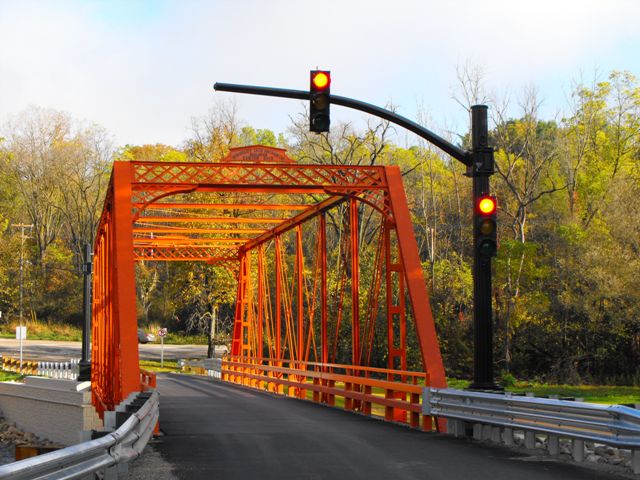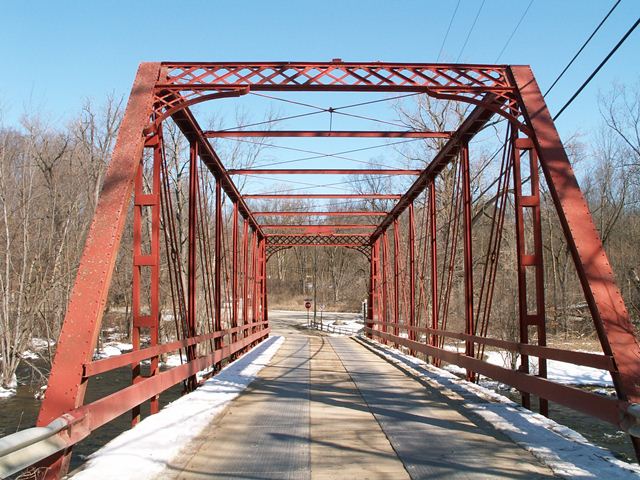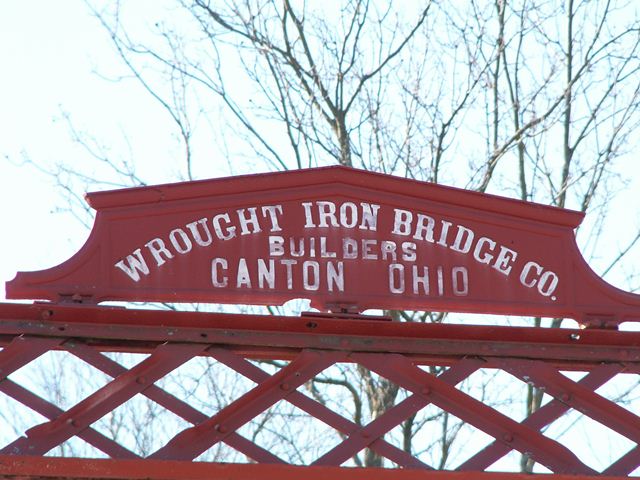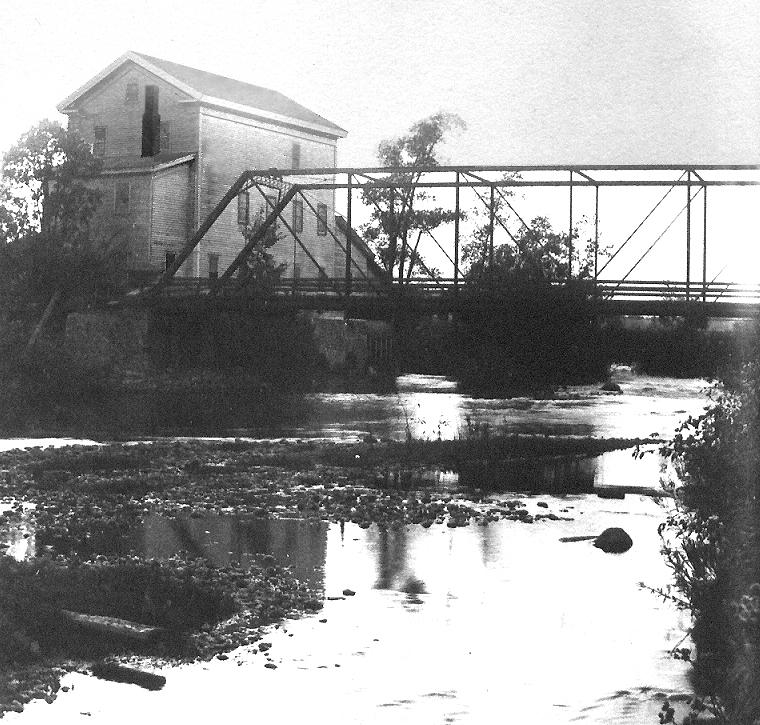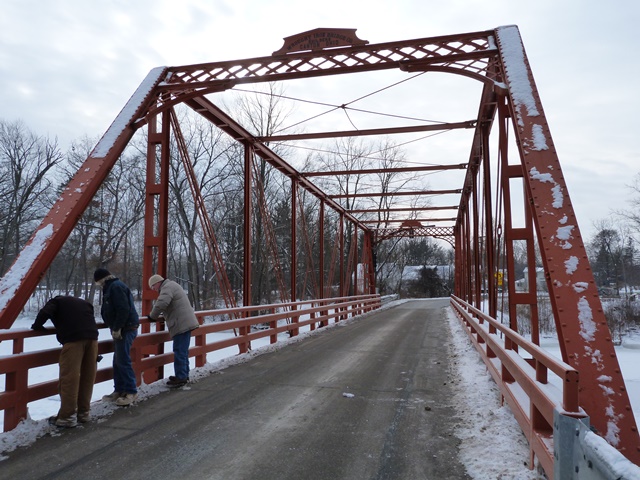We Recommend:
Bach Steel - Experts at historic truss bridge restoration.
East Delhi Road Bridge
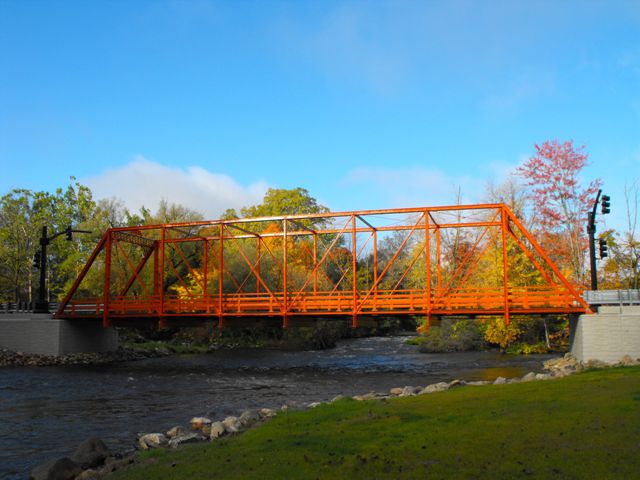
Primary Photographer(s): Nathan Holth
Bridge Documented: March 13, 2005, October 9, 2009, and January 15, 2015
Delhi Mills: Washtenaw County, Michigan: United States
By Builder/Contractor: Wrought Iron Bridge Company of Canton, Ohio
2008
109.0 Feet (33.2 Meters)
109.0 Feet (33.2 Meters)
16 Feet (4.88 Meters)
1 Main Span(s)
81308H00036B010

View Information About HSR Ratings
Bridge Documentation
View Archived National Bridge Inventory Report - Has Additional Details and Evaluation
View the Citizens for East Delhi Bridge Conservancy's Mission Statement
View The Determination of Eligibility For the National Register of Historic Places
View The Rededication Flyer For This Historic Bridge
View A Flyer By The Washtenaw County Road Commission Discussing The Rehabilitation Project
About The Bridge
This is one of those truss bridges that is not only historic, but it also has a very positive influence on its surrounding environment. This bridge is located in a very picturesque setting. There is a metro park right by this bridge, which offers some good views of the bridge. Ruins of the Delhi Mills are still visible in the area, with some pretty rapids in the river in that area now also. The area is wooded, and the bridge seems to fit right in with its rural turn of the 20th century appearance. The demolition of this bridge and replacement with a modern slab of concrete would have had a severely detrimental effect on the beauty of the area. Instead the local community successfully convinced the county road commission to rehabilitate this bridge.
This eight panel pin-connected Pratt through truss is historically significant as an example of a once-common structure type that has become rare today due to demolition. This particular example is noteworthy as a bridge displaying the unique details (and builder plaque) that show the designs and work of an important and prolific bridge company, the Wrought Iron Bridge Company of Canton, Ohio.
A metal through truss at Delhi Mills was built by the Wrought Iron bridge Company in 183, and replaced a wooden bridge at the location. There were actually once six locations along the Huron River that had both a mill and a metal truss bridge. The East Delhi Road Bridge, and Maple / Foster Road Bridge are the only two functioning truss bridges remaining. The Bell Road Bridge is still around, but it sits off of its abutments on the ground next to the river. The rest are completely gone. All of these bridges, including the truss bridge that the current East Delhi Bridge replaced, were built by the Wrought Iron Bridge Company. There must have been an agent for the bridge company who did a very good job as marketing the Wrought Iron Bridge Company's bridges since it does not appear any other bridge companies even stood a chance of having their products chosen.
What Happened in 1918? Two Possibilities: You Decide!
The truss bridge that was originally at this crossing was built in 1883. In 1918, it was knocked into the river and severely damaged. What happened afterward is the subject of substantial debate. A committee that studied the bridge feels that the 1883 was repaired and put back on its abutments, with the abutments being repaired and reused. The portal bracing, specifically the knees, would have been replaced at this time since they changed based on historical photos. A detailed report about the bridge was made and explains this theory. Other people who were not part of the study, but have experience with historic bridges felt that following its collapse by tornado, the old bridge was disposed of and a different bridge was put in its place. This theory is due to a number of members in a historical photo that appear to be bent beyond their elastic limit (meaning they could not be straightened). Also, the abutments were repaired and someone at this time put some truss bridge parts including a hip vertical and hanger, inside the fresh concrete (as a crude method of reinforcement) that was placed to change the configuration of the crossing slightly. Under this theory, this "new" bridge was actually another truss bridge of the same design, from the same era, and built by the same company, which was likely either in storage or being replaced. As odd as it may seem today to relocate a bridge in this manner, it was far from unusual back in the past. Truss bridges were like Erector sets and could be easily relocated. Plus, townships tended to be rather thrifty as federal aid funding for bridges was only in its infancy and mostly dedicated to state trunkline development. Therefore, reusing bridges made sense. That there would have been another Wrought Iron Bridge Company truss bridge of similar appearance in the area is not far-fetched... the county seems to have preferred to work with this company... since even today there are three bridges surviving built by the company. This second theory may well be entirely incorrect. Perhaps the truss members inside the abutment came from some other truss bridge the county had scrapped out. But it should be noted that if the county did indeed repair and reinstall the exact same 1883 truss in 1918 after it was blown in the river this would have been exceedingly unusual. In 1918, bridges that collapsed in this manner were not usually repaired. They were either replaced with new bridges, or other bridges were reused. This is confirmed by study of other bridges in the country of similar design.

Above: Bridge Prior To Rehabilitation.
Technical Analysis and Comparisons
The East Delhi Road Bridge has several features that are similar to the Maple Road Bridge, also known as Foster Road Bridge, which is only three miles away. The East Delhi Road bridge is an eight panel Pratt through truss. There is no v-lacing on any members. It has an intact plaque, which credits the Wrought Iron Bridge Company with building the bridge. All of these features are shared with the Maple Road Bridge. The guardrails on this bridge are either original, or a very old replacement, and appear to be identical to the Maple Road Bridge's guardrails, prior to the bridge's restoration. These similarities are due to the fact that they were built by the same company and also follow the same design plan, which would have been the property of the Wrought Iron Bridge Company, and thus unique to that company, since these bridges were built prior the era we live in today where government agencies design the standard designs for bridge construction. Despite these similarities, the East Delhi Road Bridge is still delightfully different. A different plaque and portal bracing give this bridge a completely different feel.

Citizens for the East Delhi Bridge Conservancy
This is a group of concerned citizens in the area who formed and worked to successfully save this bridge and see it rehabilitated for a number of different reasons. They understood all of the benefits a beautiful and historic truss bridge has to offer a community. Thanks to their efforts, this bridge will has undergone a rehabilitation and upon completion, the bridge will be ready to serve light vehicular traffic for generations to come. The efforts and ideas that this bridge conservancy held were good, valid ideas and although the bridge is saved today, their mission statement and concerns that resulted in the preservation of the bridge hold true today as reasons why this bridge and others like it are preserved. Here is their mission statement.
|
Mission Statement We, the Citizens for the East Delhi Bridge Conservancy, resolve to:
|
Concerns That Prompted Action The destruction of a beloved landmark. The loss of a unique focal point for artists, writers,
hikers, and park visitors. The possible destruction of remnants of the 19th century
millworks of Delhi Mills Village. Changes to the ecology of the river and its banks. The impact on kayakers, canoeists, and bicyclists. The loss of a safe and scenic bike route. The impact on a favorite fishing spot. Increase in traffic and development in one of the most pristinely beautiful areas remaining in the county. |
This bridge is tagged with the following special condition(s): Unorganized Photos
![]()
Photo Galleries and Videos: East Delhi Road Bridge
General Bridge Photo-Documentation
Original / Full Size PhotosA collection of overview and detail photos from after rehabilitation taken in October 2009. This gallery also includes some photos from during rehabilitation, as well as a few pre-rehabilitation photos for comparison. This gallery offers photos in the highest available resolution and file size in a touch-friendly popup viewer.
Alternatively, Browse Without Using Viewer
![]()
General Bridge Photo-Documentation
Mobile Optimized PhotosA collection of overview and detail photos from after rehabilitation taken in October 2009. This gallery also includes some photos from during rehabilitation, as well as a few pre-rehabilitation photos for comparison. This gallery features data-friendly, fast-loading photos in a touch-friendly popup viewer.
Alternatively, Browse Without Using Viewer
![]()
Pre-Rehabilitation Overview
Original / Full Size PhotosA collection of overview photos that show the bridge as a whole and general areas of the bridge. Taken in March 2005. This gallery offers photos in the highest available resolution and file size in a touch-friendly popup viewer.
Alternatively, Browse Without Using Viewer
![]()
Pre-Rehabilitation Details
Original / Full Size PhotosA collection of detail photos that document the parts, construction, and condition of the bridge. Taken in March 2005. This gallery offers photos in the highest available resolution and file size in a touch-friendly popup viewer.
Alternatively, Browse Without Using Viewer
![]()
Pre-Rehabilitation Overview
Mobile Optimized PhotosA collection of overview photos that show the bridge as a whole and general areas of the bridge. Taken in March 2005. This gallery features data-friendly, fast-loading photos in a touch-friendly popup viewer.
Alternatively, Browse Without Using Viewer
![]()
Pre-Rehabilitation Details
Mobile Optimized PhotosA collection of detail photos that document the parts, construction, and condition of the bridge. Taken in March 2005. This gallery features data-friendly, fast-loading photos in a touch-friendly popup viewer.
Alternatively, Browse Without Using Viewer
![]()
Historical Photos
Original / Full Size PhotosA collection of black and white historical photos of the bridge. This gallery offers photos in the highest available resolution and file size in a touch-friendly popup viewer.
Alternatively, Browse Without Using Viewer
![]()
Additional Unorganized Photos
Original / Full Size PhotosA supplemental collection of photos that are from additional visit(s) to the bridge and have not been organized or captioned. This gallery offers photos in the highest available resolution and file size in a touch-friendly popup viewer.
Alternatively, Browse Without Using Viewer
![]()
Additional Unorganized Photos
Mobile Optimized PhotosA supplemental collection of photos that are from additional visit(s) to the bridge and have not been organized or captioned. This gallery features data-friendly, fast-loading photos in a touch-friendly popup viewer.
Alternatively, Browse Without Using Viewer
![]()
Maps and Links: East Delhi Road Bridge
Coordinates (Latitude, Longitude):
Search For Additional Bridge Listings:
Bridgehunter.com: View listed bridges within 0.5 miles (0.8 kilometers) of this bridge.
Bridgehunter.com: View listed bridges within 10 miles (16 kilometers) of this bridge.
Additional Maps:
Google Streetview (If Available)
GeoHack (Additional Links and Coordinates)
Apple Maps (Via DuckDuckGo Search)
Apple Maps (Apple devices only)
Android: Open Location In Your Map or GPS App
Flickr Gallery (Find Nearby Photos)
Wikimedia Commons (Find Nearby Photos)
Directions Via Sygic For Android
Directions Via Sygic For iOS and Android Dolphin Browser
USGS National Map (United States Only)
Historical USGS Topo Maps (United States Only)
Historic Aerials (United States Only)
CalTopo Maps (United States Only)



